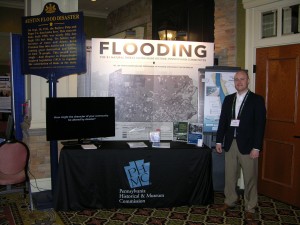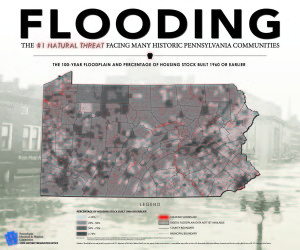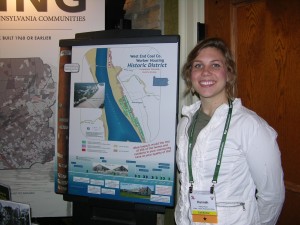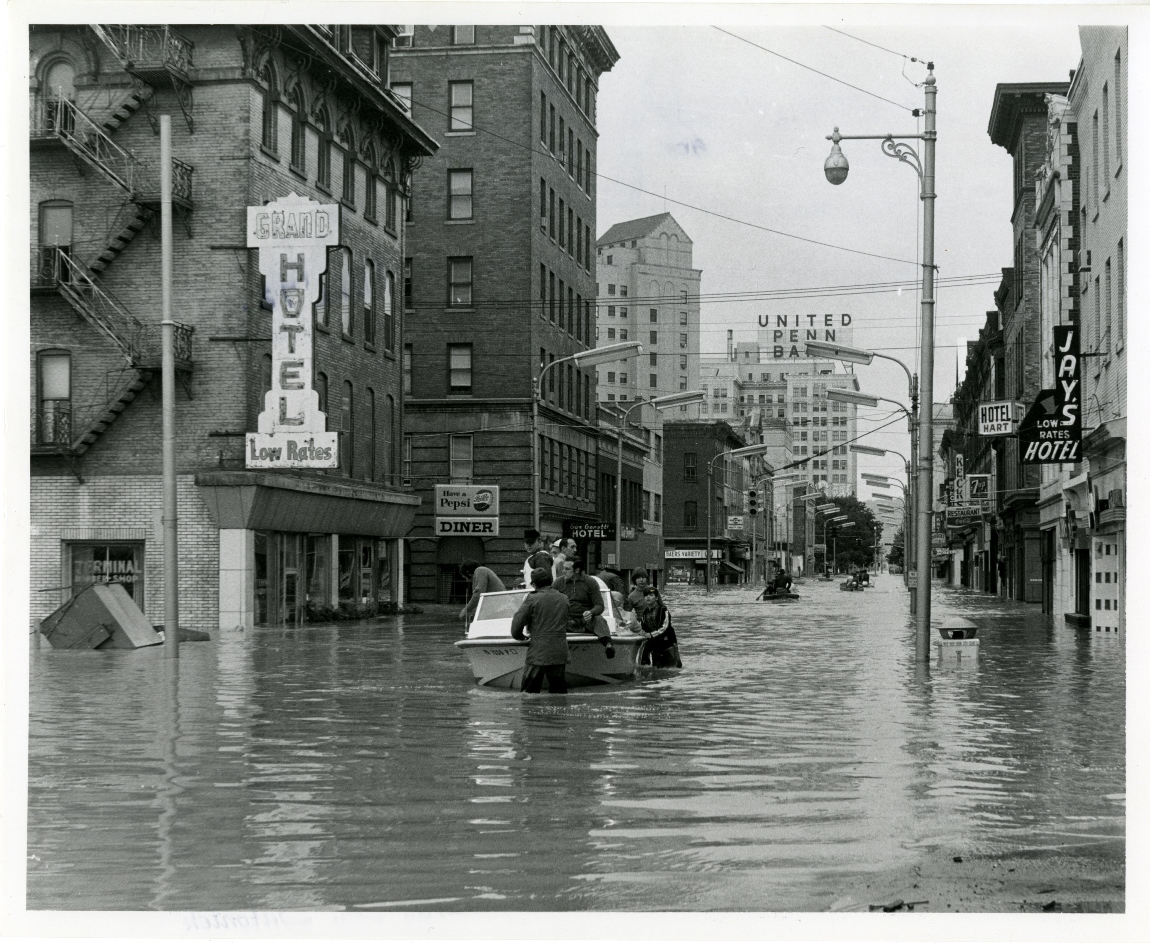Staff from the PA State Historic Preservation Office were on location at the Pennsylvania State Association of Township Supervisors’ (PSATS) 93rd Annual Educational Conference and Trade Show in Hershey, Dauphin County, from April 19-21 to promote the Commonwealth’s new Disaster Planning for Historic Properties Initiative and to convey the importance of considering the impacts of a variety of natural disaster types upon historic resources.

PA SHPO’s Disaster Planning Project Manager Jeremy Young at this year’s new “flood disaster” themed exhibit, displayed at the 2015 PSATS conference in Hershey.
SHPO staff Jeremy Young, Andrea MacDonald, Dave Maher, Shelby Splain, and Katie Hess greeted many of the more than 4,000 conference attendees who stopped by the SHPO’s “flood disaster” themed exhibit booth to marvel at a video collage of State Archives photographs revealing the destruction reeked upon Pennsylvania’s built environment by disasters ranging from the Great Johnstown Flood of 1889 to the more recent Tropical Storm Lee (2011). Other passersby were drawn to, and some recognized, the replica “Austin Flood Disaster” Pennsylvania Historical Marker on display.
 Perhaps the main focal point of the exhibit, however, was its backdrop; an oversize poster titled “FLOODING: The #1 Natural Threat to Many Historic Pennsylvania Communities.” This poster highlights the location of the 100-year flood plains within the commonwealth and areas (U.S. Census block groups) delineated by the percentage of housing stock built prior to 1960.This poster’s primary intent is to create awareness about the intersection between flood hazard areas and potentially historic areas of our built environment—and to provoke thought about the need for historic resource survey in these areas. The map’s county and municipal boundaries allow readers to get a sense of the flood risk and the related potential impacts to historic properties within their own community.
Perhaps the main focal point of the exhibit, however, was its backdrop; an oversize poster titled “FLOODING: The #1 Natural Threat to Many Historic Pennsylvania Communities.” This poster highlights the location of the 100-year flood plains within the commonwealth and areas (U.S. Census block groups) delineated by the percentage of housing stock built prior to 1960.This poster’s primary intent is to create awareness about the intersection between flood hazard areas and potentially historic areas of our built environment—and to provoke thought about the need for historic resource survey in these areas. The map’s county and municipal boundaries allow readers to get a sense of the flood risk and the related potential impacts to historic properties within their own community.
Flooding is particularly a threat to many of the commonwealth’s earliest settled communities, which often situated themselves along the banks of streams and rivers to take advantage of water power for industry, navigation, and transporting goods and raw materials. Today, many of these older communities are stuck dealing with the consequences of their founders’ decision to build in the floodplains, and are struggling to mitigate the impacts of repetitive flooding on their homes, businesses, and historic community fabric.

Spring 2015 T.H.I.S. Intern Hannah Keck proudly displaying her poster on the impacts of repetitive flooding on Luzerne County’s village of Mocanaqua and its West End Coal Company Worker Housing Historic District.
PA SHPO’s very own Spring 2015 T.H.I.S. (The Harrisburg Internship Semester) Intern Hannah Keck (Clarion University of Pennsylvania ’15) designed and exhibited a poster demonstrating the likely impacts of one flood mitigation alternative widely used by the Federal Emergency Management Agency—acquisition & demolition—on the flood-prone village of Mocanaqua in Conyngham Township, Luzerne County. Mocanaqua, which sees repetitive flooding due to its location along the shore of the Susquehanna River, was most recently ravaged by the floodwaters brought on by Tropical Storm Lee in the fall of 2011, and now has nearly 25% of its housing stock proposed for demolition to remove the structures from the floodplain.
In addition to displaying the PA SHPO’s new educational exhibit at the PSATS conference, Disaster Planning Project Manager Jeremy Young had the opportunity to co-present with staff from the Pennsylvania Emergency Management Agency and the Recovery Resources Team of the PA Department of Community and Economic Development in a session titled “Disaster Planning for Historic Communities: Integrating Hazard Mitigation and Historic Preservation in Pennsylvania.” In addition to learning how the PA SHPO will be assisting several counties throughout the commonwealth with integrating historic property considerations into their FEMA-approved hazard mitigation plans for the first time, session attendees also learned about a variety of FEMA and PEMA hazard mitigation assistance programs available to historic communities and mitigation techniques commonly employed for historic buildings, as well as how the new federal National Disaster Recovery Framework’s Natural and Cultural Resources Recovery Support Function will help to facilitate and streamline the process of recovering local historic properties in the wake of a disaster event.
Are you a member of an organization that is seeking educational displays or training sessions for an upcoming conference or workshop series? The PA SHPO will be engaging the public through 2017 on a variety of disaster planning, mitigation, response, and recovery topics as they relate to historic communities as part of the Disaster Planning for Historic Properties Initiative. Please contact Project Manager Jeremy Young (717.787.0771 or jereyoung@pa.gov) to inquire about having the PA SHPO display its new disaster-themed exhibit and/or present on the importance of planning for your community’s cherished historic properties before the next disaster strikes.
This material is based upon work assisted by a grant from the U.S. Department of the Interior, National Park Service. Any opinions, findings, and conclusions or recommendations expressed in this material are those of the author(s) and do not necessarily reflect the views of the U.S. Department of the Interior.
Comment Policy
PHMC welcomes and encourages topic-related comments on this blog. PHMC reserves the right to remove comments that in PHMC’s discretion do not follow participation guidelines.
Commenters and Comments shall be related to the blog post topic and respectful of others who use this site.
Commenters and Comments shall not: use language that is offensive, inflammatory or provocative (this includes, but is not limited to, using profanity, obscene, or vulgar comments); disparage other commenters or people; condone illegal activity; identify the location of known or suspected archeological sites; post personal information in comments such as addresses, phone numbers, e-mail addresses or other contact details, which may relate to you or other individuals; impersonate or falsely claim to represent a person or an organization; make any commercial endorsement or promotion of any product, service or publication.
If you would like to comment on other topics not related to this blog post but related to PHMC, please fill out the PHMC Contact Us Form.

I couldn’t believe that mitigation efforts are to tear down and destroy. Like cutting down trees to prevent forest fires. Makes no sense to me. Sorry solution.
Should be called Pennsylvania Historic Destruction not Pennsylvania Historic Preservation.
Thanks for your comments and your concern, Lorraine. It is indeed unfortunate that acquisition/demolition is one of the more common mitigation alternatives used for buildings (including historic ones) in flood prone areas in many parts of the state, versus other alternatives such as elevation, relocation, or flood proofing. To clarify, the Pennsylvania State Historic Preservation Office (SHPO) is not calling for the demolition or destruction of historic properties in hazard prone areas. Rather, through its Disaster Planning for Historic Properties Initiative, the SHPO is working with state and federal agency partners and communities to identify the most effective (and appropriate) mitigation strategies for historic properties that will enable them to be protected and preserved for future generations.